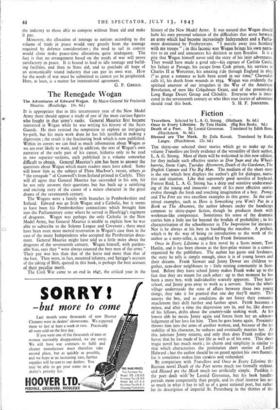The Renegade Wogan
The Adventures of Edward Wogan. By Major-General Sir Frederick Maurice. (Routledge. 10s. 6d.) IT is appropriate that in this tercentenary year of the New Model Army there should appear a study of one of the most curious figures who fought in that army's ranks. General Maurice first became interested in Wogan while he was writing his history of the Scots Guards. He then resisted the temptation to explore an intriguing by-path, but his main work done he has felt justified in making a digression ; the result is the fascinating book which is now published. Within its covers we can find as much information about Wogan as we are ever likely to want, and in addition, the text of Wogan's own narrative of the early part of his career, hitherto only to be read in two separate-sections, each published in a volume somewhat difficult to obtain. General Maurice's aim has been to answer the questions about Wogan which many readers must have asked. Some will know him as the subject of Flora Maclvor's verses, others as " the renegade " of Cromwell's from Ireland printed in Carlyle. They will all agree that General Maurice has succeeded in his aim, for he not only answers their questions but has built up a satisfying and exciting story of the career of a minor character in the great drama of the seventeenth century.
The Wogans were a family with branches in Pembrokeshire and Ireland. Edward was an Irish Wogan and a Catholic, but it seems to have been his Pembrokeshire connections which brought him into the Parliamentary army where he served in Haselrigg's regiment of dragoons. Wogan was perhaps the only Catholic in the New Model Army, but General Maurice is unable to explain how he was able to subscribe to the Solemn League and Covenant ; there must have been even more mental reservation in Wogan's case than in the case of the many Independents who accepted the Presbyterian docu- ment. General Maurice might have told us a little more about the dragoons of the seventeenth century. Wogan himself, with pardon- able bias, says they " were always counted the best men of the army." 'Their pay was less than that of the horse and more than that of the foot. They were, in fact, mounted infantry, and Sprigge's account of the taking of Nth, quoted in this book, is perhaps the best account of their peculiar merit.
The Civil War came to an end in 1647, the critical year in the history of the New Model Army. It was natural that Wogan should hate his own personal solution of the difficulties that arose between an army which had become increasingly Independent and a Parlia- ment dominated by Presbyterians. " I marcht away into Scotland with my troope " ; in this laconic way Wogan brings his own narra- tive to an end and announces his decision to turn Royalist. It is a pity that Wogan himself never told the story of his later 'adventures. They would have made a good tale—his capture of Carlisle Castle, his failure at Passage, his escape from Cork prison, his services to Charles II at Worcester, his amazing ride through England in 1653 (" as great a romance as bath been acted in our time," Clarendon calls it), his death from wounds in 1654. Wogan was evidently the spiritual ancestor of our irregulars in the War of the American Revolution, of men like Colquhoun Grant, and of the present-day Long Range Desert Group and Chindits. Everyone who is inter- ested in the seventeenth century or who likes true stories of adventure


























 Previous page
Previous page